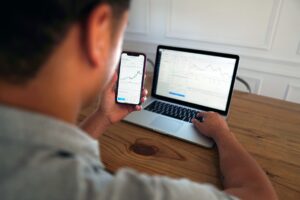How to Calculate Leverage in Forex Trading and Its Significance
Forex trading is a highly popular form of investment that attracts millions of traders from around the world. One of the key aspects of forex trading is the use of leverage, which allows traders to amplify their potential profits. However, leverage can also magnify losses, making it essential for traders to understand how to calculate leverage and its significance in forex trading.
What is Leverage?
Leverage is a tool that enables traders to control larger positions in the market with a smaller amount of capital. It essentially allows traders to borrow money from their broker to trade in the forex market. Leverage is expressed as a ratio, such as 1:100, 1:200, or even higher.
For example, with a leverage ratio of 1:100, a trader can control a position worth $100,000 with a margin deposit of only $1,000. This means that the trader is effectively trading with 100 times more money than they have in their account.
How to Calculate Leverage
To calculate leverage, you need to know two key factors – the total value of your trading position and the margin required by your broker.
The leverage formula is as follows:
Leverage = Total Value of Trading Position / Margin Required
For example, if you have a trading account with $10,000 and your broker requires a margin of 2%, you can calculate the leverage as follows:
Leverage = $10,000 / ($10,000 x 0.02) = $10,000 / $200 = 50:1
So, in this case, the leverage ratio is 50:1, meaning you can control a position 50 times larger than the amount of money in your account.
Significance of Leverage in Forex Trading
Leverage can significantly impact the profitability and risk of forex trading. Understanding its significance is crucial for traders to make informed decisions and manage their risks effectively.
1. Amplification of Profits and Losses
The primary benefit of leverage is the ability to amplify potential profits. When the market moves in your favor, a small price change can result in substantial gains. For instance, with a leverage ratio of 50:1, a 1% increase in the value of the traded currency pair can yield a 50% return on your investment.
However, it is important to remember that leverage also magnifies losses. If the market moves against your position, even a small price change can lead to significant losses. Traders need to be cautious and set appropriate stop-loss orders to limit potential losses.
2. Margin Requirements and Account Balance
Leverage also affects the amount of margin required by your broker. The higher the leverage ratio, the lower the margin requirement. This means that traders can open larger positions with a smaller amount of money.
However, traders must be mindful of the impact of leverage on their account balance. A high leverage ratio can deplete the account balance quickly if the market moves unfavorably. It is essential to manage risk and use appropriate position sizing strategies to avoid excessive losses.
3. Risk Management
Leverage plays a crucial role in risk management. Traders need to carefully assess their risk tolerance and choose an appropriate leverage ratio. A higher leverage ratio may provide the opportunity for larger profits, but it also increases the risk of significant losses.
It is recommended for beginners to start with lower leverage ratios to gain experience and understand the dynamics of the forex market. As traders become more experienced and confident, they can gradually increase their leverage ratio.
4. Market Volatility
Market volatility is another factor to consider when using leverage in forex trading. Highly volatile markets can result in rapid price fluctuations, increasing the risk of losses. Traders should be cautious and adjust their leverage ratios accordingly during periods of high market volatility.
Conclusion
Leverage is a powerful tool that can amplify profits and losses in forex trading. Traders must understand how to calculate leverage and its significance to make informed trading decisions. It is essential to manage risk effectively, set appropriate stop-loss orders, and choose an appropriate leverage ratio based on individual risk tolerance and market conditions. By utilizing leverage wisely, traders can maximize their potential returns while minimizing the risk of significant losses.





